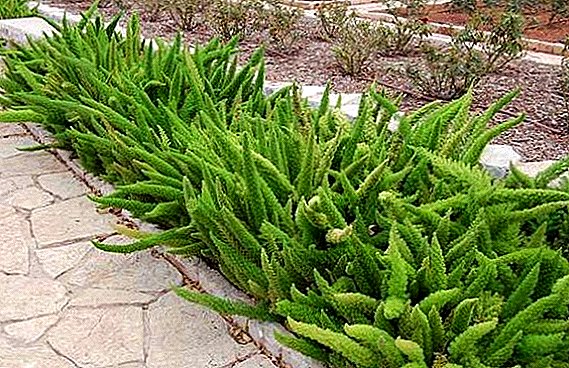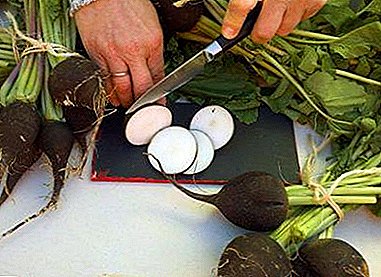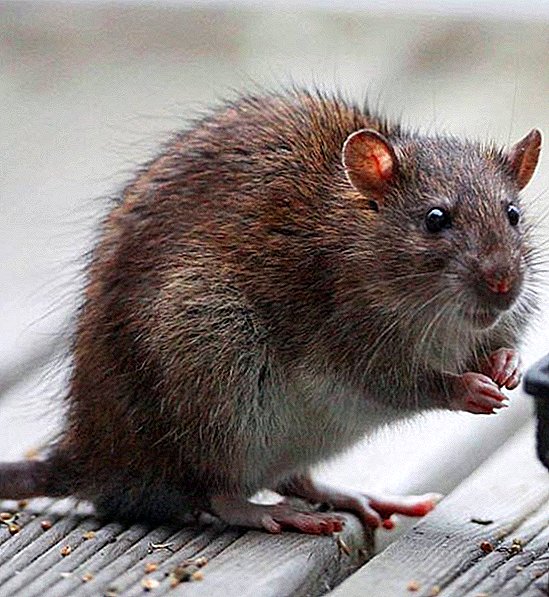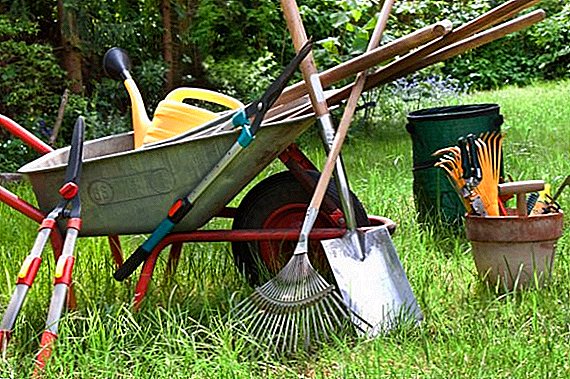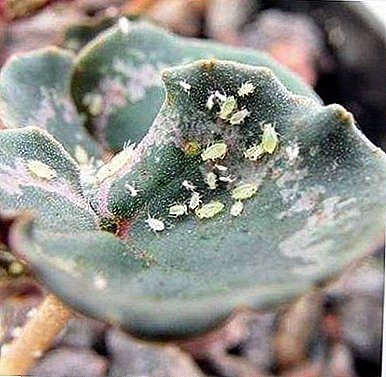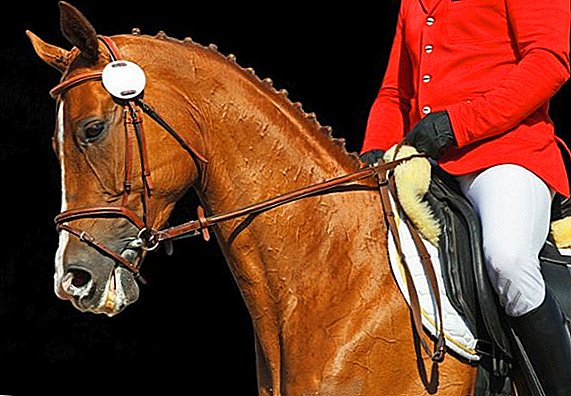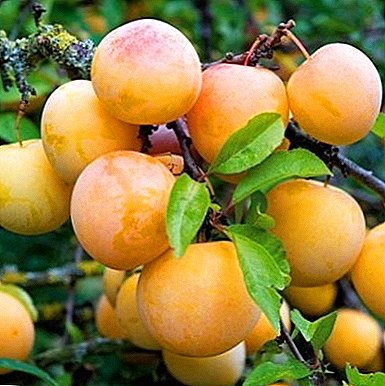
For many years, breeders have been solving the most difficult task - the creation of such fruit varieties, which, despite their original thermophilia, would be able to give the inhabitants of the northern countries all the tenderness of their aroma and delicacy taste of southern fruits.
Along the way, many plum surveyors pay close attention to numerous representatives Ussuri and Chinese breeding.
And all thanks to the great diversity of their beneficial properties.
One of these plums, recommended for cultivation in regions with fairly harsh climatic conditions, is the Chinese variety of plums. "Yellow Hoops".
Description of the plum "Yellow Hoppies"
This fruit crop has the following specific external and structural characteristics:
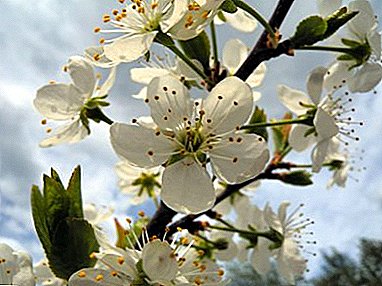 Tree. It is a vigorous plant (rarely - moderate in growth).
Tree. It is a vigorous plant (rarely - moderate in growth).Its height is usually 2.5 m or more. At the same time the tree trunk itself is relatively not very high.
The bark on the plum stem is smooth to the touch, mostly gray.
- Crown, branches. In an adult individual, a sparse (sometimes of medium thickness) tip is formed in the form of a slightly flat circle.
Crown forms largely sprawling branches. Smooth skeleton bark has a gray color.
- Shoots. Straightened (sometimes somewhat curved) shoots are distinguished by a rather thick section. The color of the shoots is light brown, some glossiness is observed on the surface. On the shoots a large number of small lentils are formed.
The buds of the vegetative type are very small in size, while the fruit buds are of medium size.
- Leaves. Sizes - from medium to large. The length of a regular sheet is 11 cm, width - 6 cm. The maximum expansion is observed closer to the top.
Leaves grow egg-shaped. Primary color - green, with a slight sheen. On the surface of the sheet there are subtle wrinkles.
- Inflorescences. Mid-sized white flowers bloom in the form of cups.
The egg-shaped petals are 9 mm long and 7 mm wide. On the edges of the petals there is a slight waviness. Usually 2-3 flowers are collected in one bud.
- Fruit. Yellow or light yellow color fruits with a whitish wax coating are characterized by average size, weighing between 16-20 g.
The shape is generally rounded, there is a slight flatness. On the abdomen of the fetus is well visible seam. Under the thin skin of the flesh is a yellow-green hue, quite loose, rich in juice.
Inside is a relatively large bone, which is easily separated from the pulp.
A photo
You can get acquainted with the “Yellow Hopta” plum in the photo below:



Breeding history
Plum variety "Yellow Hoops" was bred in 1930 by the Russian breeder N.Tikhonov. Studies were carried out in the city of Ussuriysk, in the garden of the amateur gardener Hopta.
Tikhonov did a lot for the practical cultivation of fruit novelties in the Asian half of Russia. In subsequent years, the specified plum has become one of the main varieties in gardening farms in Siberia, the Urals and the Far East.
Already in 1974, the “Yellow Hoppies” was included in the state variety register and officially zoned in the West Siberian and Ural regions.
From the very beginning of its existence, this plum variety has been actively used by many scientists-breeders when creating new high-quality varieties.
In particular, for the Altai region with the participation "Yellow Hoops" Zarya Altai and several other promising species were bred; in Krasnoyarsk, Divnaya plum.
From "Yellow Hoops" its good adaptability to local natural and climatic conditions, good yield is transferred to new varieties. However, her offspring can receive from the "parent" and a distinct bitterness of her skin.
Characteristics of a variety
This plum refers to the self-fertile fruit crops. Such plants, as a rule, are almost devoid of the ability to self-fertilize due to pollination by their own pollen.
 For this reason, planting a tree in the garden varieties "Yellow Hoops", the gardener needs to locate nearby trees of other plum varieties, which bloom occurs at the same time when the described plum blooms.
For this reason, planting a tree in the garden varieties "Yellow Hoops", the gardener needs to locate nearby trees of other plum varieties, which bloom occurs at the same time when the described plum blooms.
The variety breeds through vaccination. Currently, the best stocks for "Yellow Hoops" Some varieties of the Ussuri and Canadian selections are considered.
The normal fruiting of this plum begins at 3-4 years after planting an annual seedling. Subsequently, subject to all the necessary agrotechnical conditions, the tree produces quite decent harvests every year. In particular, on average from one plant per season you can get up to 10-12 kg of fresh plums (or about 40-60 centners from one hectare).
At the same time, the fruits, which usually ripen in August - early September, turn out to be pleasantly palatable, dominated by sweetness with a slight attractive sourness. However, the weak point of the overall flavor bouquet is the skin, which gives some bitterness.
Here you need to be especially careful, as this disadvantage can be transmitted to the products of processing. "Yellow Hoops".
The fruits contain The following chemical elements:
- sugar - 13.6%;
- titrated acids - 1.7%;
- dry substances - 21.8%;
- tannins - 0.74%;
- ascorbic acid - 12 mg / 100 g;
- P-active substances - 150 mg / 100 g
It should also be noted good winter hardiness this variety. To a greater extent it concerns wood. But the fruit buds can not withstand severe frosts, which must be considered when breeding plums.
Ripe plum fruit is best eaten fresh. Due to the delicate skin and friable pulp, plums of this variety do not tolerate long-distance transportation.
Features of planting and care
An annual tree is planted in a well-lit, windless, slightly elevated place where underground water does not come close (no closer than 1.5-2 m) and where fertile soil prevails (acidic soils are not recommended for plum).
 Under planting, dig a hole with a depth of 50 cm and a diameter of 80 cm. Before planting, the pit should be allowed to settle for 1.5-2 weeks.
Under planting, dig a hole with a depth of 50 cm and a diameter of 80 cm. Before planting, the pit should be allowed to settle for 1.5-2 weeks.
After filling the root system with a soil mixture, in which organic and mineral fertilizers should be added, the root neck of the seedling should rise 5-6 cm above the ground.
Care for the plum "Yellow Hops" practically no different from the technology of care for any other plum plant. It includes regular loosening of land near a tree, weed control, and watering.
Learn more about other varieties of Chinese plum: Orel dream, Xenia, Skoroplodnaya, Alyonushka.
At the same time in the dry season on 1 square. The projection of the tree crown uses 1 bucket of water. Young trees require (especially in the dry period) more frequent irrigation than adult plants.
In order to get good and regular crops, it is recommended to apply top dressing in the form of 3 kg of manure (compost) per 1 sq. m pristvolnogo plot.
For optimal fruiting, the tree needs regular pruning. And from the severe frosts, youngsters in the first 3-4 years of life are advised to cover with sacking, which is wrapped in 2 layers around the trunk.
Diseases and pests
Grade "Yellow Hoops" demonstrates quite good resistance to attacks of the hawthorn, as well as to nodule. At the same time, insects can cause great harm to the plant - Semyaed of Maslovsky.
Voracious larvae of this Hymenoptera almost completely eat the grain. As a result, plums dry up, turn black and fall off.
To effectively combat this pest, summer spraying (in mid-June) with a 0.2 percent solution of lepidocide or chlorophos is used. And already struck fruits are better for collecting from a tree in advance.
Tasty and fragrant fruits of this Chinese plum can be a real decoration of the feast and an excellent option for its dessert part. However, all this will be possible only after the knowledge, experience and constant labor applied to the plant.


 Tree. It is a vigorous plant (rarely - moderate in growth).
Tree. It is a vigorous plant (rarely - moderate in growth).